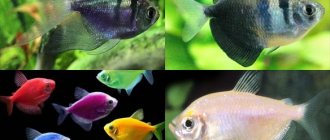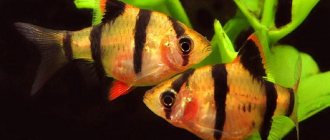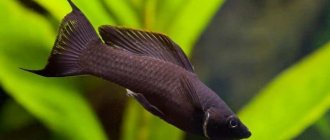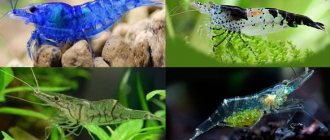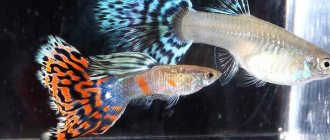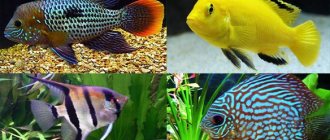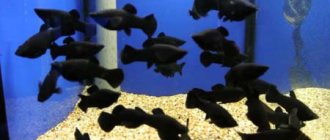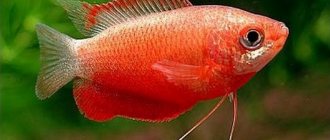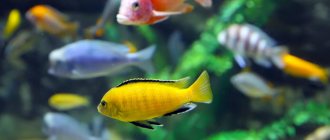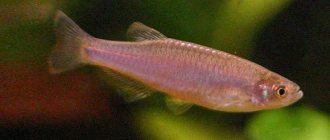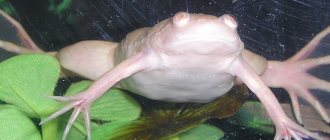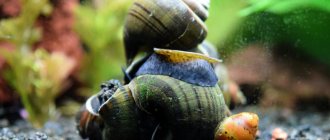Guppy fish are one of the most famous species among aquarium fish. They are very easy to care for. They will please the eye and lift your spirits.
In this article we will look at everything about guppies: history; habitat; life expectancy; about care; feeding; sexual differences; species names; compatibility with other fish; reproduction; diseases, their symptoms and treatment. The information will be useful to those people who are planning to keep this beautiful type of aquarium fish.
Guppy fish
Guppy fish are tropical freshwater fish native to South America and belong to the higher class of platies.
There are almost 300 varieties of Guppies. They come in different colors, sizes and tail shapes. Females are larger than males, 6 cm in length, males 3 cm. All the bright colors of Guppies appeared as a result of selection. In the wild, Guppies are gray with some sprinkling of spots on their fins. Scales in the shape of a rhombic mesh.
The homeland of the fish is the islands called Trinidad and Tobago. Also originally found in South America, namely in the waters of Venezuela, Guiana and Brazil. Nowadays, these fish can be found on virtually all continents of the planet.
Their name comes from Robert John Lechmere Guppy, who found them in Trinidad in 1866. In the same year, he made a message to people from the Royal Society, in which he told everyone that these fish do not mark eggs, but give birth to live fry. Then they only laughed at him.
The life expectancy of Guppy depends on the conditions of detention, on average from 1-3 years.
Table of basic parameters of maintenance, care and nutrition:
| What should be the volume of an aquarium for a Guppy? | 1 liter per 1 individual |
| What should be the temperature in the aquarium for Guppy? | from +24-26° C |
| What pH should be in the aquarium? | from 6.5-7 pH |
| What should be the hardness of the water in the aquarium? | from 10-25° dH |
| What should be the substrate for an aquarium? | any - small pebbles or coarse, fine sand (suitable for living plantings) |
| What kind of lighting should be in the aquarium? | moderate |
| What should be the movement of water in the aquarium? | moderate |
| Maximum fish size | length 6 cm female, male 3 cm |
| What does aquarium fish eat? | live food: small bloodworms, daphnia, brine shrimp, coretra, cyclops, tubifex and specialized dry food |
| Type of aquarium fish | peaceful |
| Who is compatible with in an aquarium? | compatible with all peaceful |
| Lifespan | up to 3 years |
Fry
How many fry a female can produce at one time depends on her size and development. On average, young fish bring 20-25 babies at a time, adults and large fish – up to one and a half hundred.
Guppy fry are born very tiny, often even difficult to see. Their translucent, grayish coloring, against which only their dark eyes stand out, also plays a big role in this. The cubs are actively growing, and after 30-40 days of life they begin to acquire “adult” coloring, and their sex begins to be determined. At the same time, it is worth transferring them from the spawning tank (if they were kept there) to a larger container.
Experts believe that food should be plentiful and around the clock. At first, it is recommended to give live dust, brine shrimp, rotifers, and microworms.
Babies do not require special care. It is very easy to determine what to feed guppy fry. The main thing to consider is the size of their mouth. The food should be small enough for the miniature fish to swallow it. You can use specialized food for juveniles or, in extreme cases, ground dry daphnia, gammarus, and cyclops.
Some experienced aquarists offer mashed boiled egg yolk and hard-boiled milk as food for the first time. Keep in mind that the remnants of such food must be immediately and very carefully removed from the aquarium - they instantly rot and the water can deteriorate. What to feed the guppy fry when they grow up is also easy to decide - the usual food that you use for all other fish.
Babies are transplanted into a community aquarium when they grow large enough not to be eaten.
Aquarium fish Guppy maintenance and care, feeding
Many people choose Guppies not only because of their beautiful appearance, but also because of their fairly simple care and maintenance conditions. The size of the aquarium is no less than 1 liter per 1 individual - this is for comfortable keeping.
We must not forget that fish need constant filtration and water changes. Aquarium fish Guppy are suitable for those who have just started to get interested in keeping and breeding fish, since they do not provide the owner with much trouble.
It is recommended to plant the container where the fish will live with various vegetation such as: Vallisneria; Limnophila; Saggitaria; Elodea; Ludwigia. This way the pets will feel much more comfortable and freer. Temperature range from +24-26° C, water hardness from 10-25° dH, acidity from 6.5-7 pH.
These fish are omnivores. Owners should also not have any obvious problems with feeding. It is recommended to have a balanced diet, combining dry food (these are various granules and flakes) and frozen food (for example, small bloodworms, daphnia, brine shrimp, coretra, cyclops, tubifex) in the diet of the guppy fish.
How quickly they grow, what to feed and how to care for them
Guppies grow amazingly fast. Under proper housing and feeding conditions, after one and a half to two months the first males will begin to acquire a beautiful, bright color, and the first coal spots will appear.
At 3 months they are already fully formed and reach sexual maturity. The guppy's color improves and becomes clearer and more beautiful with age. The older the male, the more uniquely colored his fins and tail are.
First days
In the first days of life, the fish are already quite active. Immediately after birth, babies actively swim around the aquarium in search of food. In order for them to eat properly, it is necessary to give them only small food.
The ideal option would be brine shrimp and live sand. Sometimes you can dilute the diet with chopped boiled yolk from a chicken egg. Baby guppies eat yolk
Guppy fish, difference between female and male and their reproduction or breeding
It is not so difficult to distinguish a female Guppy from a male, you just need to look closely. Males look slightly smaller than females and are slimmer, and have a large caudal fin. Their anal fin is transformed into a gonopodium. Females look much larger, their bellies are rounder, and their coloring is pale compared to the male.
Female guppies do not mark eggs; they give birth to live fry, which have the ability to swim independently with the help of small fins throughout the aquarium from the first minutes of life.
To prevent the fry from being eaten by their relatives, it is necessary to place a large amount of vegetation and decorations in the aquarium so that the fry can hide. Cabomba and Java moss are perfect for the fry to hide and remain undetected in these dense bushes while they are small.
It is recommended to place a pregnant female in the spawning aquarium. After the fry are born, almost immediately the mother must be placed away from her offspring.
Fry can be given live nanofeeds. For example, Artemia nauplii and ciliates. Dry foods that are produced in factories and supplied to all pet stores may also be suitable, so it will not be difficult to find and purchase them. The fry grow very quickly and soon after birth they swim in one large school together with their other fish relatives.
Optimal conditions for reproduction
A pair of guppies can successfully produce offspring in a three-liter jar, but in order for the fry to grow, a larger volume is needed. By the way, in any case, especially for beginners, it is not recommended to have an aquarium smaller than 20 liters (the smaller it is, the more difficult it is to establish the necessary balance in it, paradoxically as it may seem).
Of course, it is best not to keep any other fish other than gouppies (professional aquarists limit themselves to one variety), but for a beginner, and especially for a child, this approach may seem too boring. However, you need to keep in mind that when keeping other species together, you cannot keep such active and cocky fish as barbs and cockerels: they can offend and irritate adult guppies, and they will quickly eat babies.
Be sure to plant plants: kids need secluded corners and thickets in which they will hide. Dense types of plants are a good help; Java moss is ideal. Floating plants are also suitable (pinnate, hornwort, Canadian elodea, etc.)
It is advisable to have an automatic heater so that in winter the water does not cool below 22 C°. If the aquarium is not overpopulated (for guppies this means no more than 2 fish per 5 liters of water), then theoretically you can dispense with the filter and aerator, but when keeping elite guppies it is better not to do this. You just need to take into account that the internal or external filter will pose a danger to the fry: crumbs can be sucked in and die in it. Therefore, it is absolutely necessary to use foam nozzles on the water intake grille. If you can’t make or find nozzles, simply wrap the water intake with filter material and tie it with thread.
Compatibility with other fish
Guppy fish are very friendly fish and can get along with other fish species in the same aquarium. But their neighbors must also be friendly and peaceful, otherwise the Guppies can easily be eaten or intimidated. Various colorful fish can be excellent neighbors: Norman's blue-eye; Neon; Mollies; Swordtails; Danio; catfish.
Bad neighbors can be: Cichlids; Cockerels (Cockerel may perceive a male Guppy as a male Cockerel and become aggressive).
Guppy fish species
There are quite a large number of species of Guppy fish. Here are the most common Guppies: Fantails; Veil; Voile-scarf; Green; Carpets; Red-tailed Half-black; Round-tailed; Tape; Ribbon-scarf; Semi-black; Mesh; Mesh gold; Smaragdaceae; Emerald gold; Scarf ones.
Birth of fry
So, the “kindergarten” for children is ready. For childbirth, the female needs to create optimal conditions: the water temperature should be 26 - 28 degrees (in the first two weeks), aeration and lighting should be maintained constantly.
Guppies are viviparous fish. The babies are born and immediately rush to the bottom or into the thickets of vegetation. The instinct of self-preservation forces them to do this. Otherwise, the Guppy fry risk being eaten by their own mother. Maternal instinct is not inherent in this species of fish.
A primiparous female can give birth to at least 20 fry. In the future, their number can reach 180 pieces. Although newborns are only 3 – 5 mm in size, caring for baby guppies is very easy.
If everything happened as expected, the birth was not premature, and the babies should not have a visible yolk sac. If it is present, then the fish were born too early and will not be viable.
Guppy fish diseases: symptoms and their treatment
Guppies are a very hardy fish, however, like all living creatures, they are susceptible to diseases.
Skin and fin fungus
Guppies can be prone to various types of fungal infections. Fungal infection is common among these fish. This is a disease in which small white dots grow on the fish's skin and fins, and you will notice them rubbing against objects.
To get rid of the infection, you can use medications available at your local pet store.
Fin rot
They are also susceptible to fin rot and the tail will appear torn. Again, this can be treated with medication and prevented by choosing suitable companions who will not suppress.
Infertility
Guppies are prone to infertility. Then the fish become unable to reproduce and give birth. You can tell that a fish has become infertile by its color. The color of the fish fades significantly. Also, the red color, which almost every fish of this species has, may simply disappear from the coloration. This disease in fish can occur due to an excess of lighting in the aquarium.
Male underdevelopment
Guppy fish face the problem of poor development of males. It often happens that male fry grow rather poorly and slowly. Even when they finally mature, they may not gain their full height and weight, and their coloring also becomes very faded and sickly.
Hermaphroditism
A common case of hermaphroditism. With this disease, in females not only the ovary develops, but also the testis. The testis is the male reproductive organ of fish. In such cases, the fish is able to fertilize itself and create new offspring.
To reduce the chance of disease entering your aquarium:
- keep water conditions optimal;
- Perform ongoing water changes and maintenance checks;
- always wash everything or quarantine things before adding them to your aquarium;
- keep their stress levels low;
- balanced diet;
- do not overfeed (overfeed).
Also, when fish become ill, obvious symptoms appear. Sometimes you can see with the naked eye that something wrong is happening to the fish. With fungal infections, the owner may notice it. Also, when diseases occur, fish become more lethargic and use less fins. Sometimes they can stop in one place and not move anywhere. Also, the fish may begin to avoid their relatives and hide in thickets or behind decorations.
We hope that the article answered questions regarding keeping Guppy, feeding, reproduction, the difference between a female and a male and possible diseases.
Launch into a community aquarium
When can you safely add fry to adult fish? The answer is simple: as soon as they grow enough to avoid being eaten. Age doesn't really matter. Some individuals can be quite large after two weeks, while others remain tiny at this time. A general rule for all fish, not just guppies: when the fry have grown to 1.5 cm, they are ready for transplanting.
Before global relocation, you need to make sure that the raised babies will survive in a common aquarium. To do this, the tank must have a lot of shelters: plants among which the guips can hide. From among the inhabitants of the aquarium, it is necessary to exclude aggressive and predatory fish, for which small guppies will become tasty prey.
On a note! The fry should be prepared for transplantation gradually: lower the water temperature, bringing the parameters of the fish tank closer to those of the general tank.
First days
This is what a newborn baby gummy looks like.
It is recommended to pay special attention to the fish during 2–3 days of life. Caring for Guppy fry is not difficult, but is important for the health of the fish.
- Feeding. In the first few days, babies should be given food 4–5 times a day in small portions. It is important that they have a rounded abdomen; the fry should always be full.
- What to feed. The diet of Guppy fry is as follows: a special store-bought mixture, Artemia larvae or the yolk of a boiled egg mixed with water. The main thing is that the food must be sufficiently crushed, otherwise the fish will not be able to swallow it.
- Feed volume. After the fry have eaten, the remains must be carefully removed from the aquarium. The food should not be constantly on the surface of the water.
- Temperature regime for guppies. For the first 14 days it is maintained around 28 degrees, after a week it can be reduced to 26, after the next - to 24
- Composition of water. For the comfort of the fish, it will be very useful to replace the water daily, by about a third, with a new portion (previously settled for 2 - 3 days)
In this way, you can raise Guppy fry in a jar, in a separate aquarium or any other container.
Pairing
The male has a special reproductive organ called a genopodia. It resembles a tube and is a modified anal fin. During the courtship dance, the males actively pursue the girl and pinch her from below or from the side. At these moments they mate.
03:12
Guppy mating games
If there are a very large number of males per female in the aquarium, or they are aggressive, then the female may die as a result of exhaustion, or jump out of the tank. Each male must have one female, two or three. There should be as few males as possible in a community aquarium, otherwise they can drive females to death.
After the eggs are fertilized, the boys are removed from the aquarium so that the mother guppy can bear the fry in peace.
Sometimes guppies don't want to breed. In order to stimulate the process, you can replace a third of the water in the tank, and also slightly increase the temperature. You can only use water that has settled well for replacement. Such measures are also taken in cases of complicated or premature birth.
If the female has mated, sperm can remain in her body for several months. Purchased female guppies that were kept in a community aquarium in a store often turn out to be pregnant. They are able to reproduce without re-mating several times.
How to determine gender by the structure of the fins?
Another difference between male and female guppies is the structure and shape of their fins. The most noticeable difference is in the structure and shape of the caudal fin. Traditionally, in females it has a simple and round shape. Relative to the body, the fins of females are always proportionally smaller than those of males.
The fins of boy guppies are elongated and elongated. The shape of the caudal fin depends on the breed of fish.
In accordance with this characteristic, it is customary to distinguish between fan-tails, lyre-tails, veil-tails, round-tails, needle-tails, spear-tails, and flag-tails. The anal fin (gonopodium) in males has a phallic shape.
Popular breeds
All types of guppies are artificial selection varieties of ordinary ones, there are more than 60 of them. The most common types that can be found on sale are blue guppies with yellow, red tails and breeds such as German red blond, red firecracker, Prussian gold, tomato, etc. d.
- German yellow guppies have a clearly defined color of yellow shades, they can be from light yellow to acidic lemon. The German breed is distinguished by a delicate golden hue, the scales shimmer from rich ultramarine to pale blue, and the head is white. This category is very common throughout Russia.
- Blue Moscow have a beautiful shiny blue color that can range from a pale blue to a dark night color. They are: cream, silver, blue-black, greenish, bluish tints and inclusions. The breeding categories have large, lush plumage and body size can reach 4 and 5 centimeters.
- Moscow blue-green guppies have a blue-green color with blue, black, white and golden splashes, and a light silver head.
- Dog breeds
- Urban dog breeds
- Origin of the cat
- Hypoallergenic dogs
- Fighting dog breeds
- The rarest cat breeds
- The Red Blonde gets its name from the bright red tone of its tail. The head is white and the body is whitish with a golden coating.
- Carpet carnation guppies . The tail of this fish resembles the ragged edges of the famous flower and is orange-red or orange with dark, dark flecks similar to an intricate rug.
- Venezuelan japonica and "Havana guppy" are dwarf guppies with pronounced colorful colors and multi-colored black, red, gold, green, blue stripes and spots.
- Veil guppies “Black Prince” or “Black Monk” - this variety was bred in Moscow and is one of the most spectacular forms. These individuals have a pronounced black tail color, their head has whitish silver and golden tones, and the fins can have silver, blue, purple and golden hues. Pedigree veiled guppies "Black Prince" may be pure black with the same gloomy eyes.
- The Red Dragon Royal Guppy is a completely scarlet guppy (bright red) with a body that can reach four centimeters. The elite individual has not only red fins and a body, but also eyes. Also in the spectrum of this rock there are golden, white and dark inclusions and coatings.
- Tiger - distinguished by a richly colored tail of predominantly orange and yellow shades with paint similar to the skin of a tiger. The tiger king has rich, provocative colors and a lush fan tail.
- Green cobra is one of the most beautiful and popular breeding forms in Russia; the body is colored greenish-golden with a silvery sheen and resembles the scales of a cobra. The plumage of the tail is yellow-green with brown stripes and spots, reminiscent of the skin of a snake. Typically this category has a round, dark, plaque-like spot at the base of the head.
- Berlin guppies . Scales from blue to dark purple, white head and tail feathers. The dorsal ones are orange and fiery.
- Guppy mix - this breed was obtained as a result of mixing different categories of elite fish and is distinguished by the deep and clear color of aquarium luxury categories.
- Neon guppies have a sky blue tail and often have silvery gold and white bellies and feathers. The spectrum contains white, dark, greenish inclusions and shimmer on the back with a silvery neon stripe.
- Guppy Sunset Micarif . Their bodies are up to four centimeters long and have a neon silver hue, the fins of this population are usually pale yellow or lemon yellow and the tail feathers are edged with red, which resembles a candle flame.
What breeds of guppies do you prefer?
It is best for beginning lovers of these creatures to opt for the simplest varieties that have beautiful names:
- Berlin guppies are veil-tailed, with red fins and a silvery body, dark at the tail (half-black);
- carpet - silver or bluish, with yellow or red fins with black speckling;
- Canadian - silver, dark towards the tail, with white fins;
- half-black leopard - with a bright yellow tail, decorated with large black spots, reminiscent of the color of a wild cat.
Some races
Standards of fin shapes for guppy breeds, adopted in Western Europe and Russia: A - narrow-angled, B - triangular, C - skirt, D - flag, E - forked, F - upper sword, G - lower sword, H - lyretail, I - spade-tailed, J - spear-tailed, K - round-tailed, L - needle-tailed
Commercial names
- 'Albino'
- 'Albino Pastell'
- 'Arctic Blue'
- 'Black'
- 'Blonde'
- 'Blonde Red Tail'
- 'Blue'
- 'Blue Diamond'
- 'Blue Grass'
- 'Blue Jeans'
- 'Blue-Lightning'
- 'Blue Metal'
- 'Blue Mosaic'
- 'Blue Neon'
- 'Blue Red-Scissortail
- 'Blue Snakeskin'
- 'Bottom Sword'
- 'Bumble-Bee'
- 'Calico Lyretail'
- 'Canadian-White'
- 'Cobra Blonde'
- 'Cobra Blue'
- 'Cobra Gold'
- 'Cobra Green'
- 'Cobra Red'
- 'Cobra Yellow'
- 'Diamond Blue'
- 'Double-Sword'
- 'Dragon Head Tuxedo'
- 'Dragon Head Tuxedo Red'
- 'Electric Blue'
- 'Flame'
- 'Flamingo'
- 'Flamingo-Gold Body'
- 'Flamingo-Tuxedo'
- 'Full Black'
- 'German Yellow Tail'
- 'Gold Laser'
- 'Golden'
- 'Golden Blonde'
- 'Golden Pheonix'
- 'Golden Snakeskin'
- 'Gold-Green Lyretail'
- 'Green Diamond'
- 'Green Glass Cobra'
- 'Green Neon Lyretail'
- 'Green Pheonix'
- 'Green Red Tail'
- 'Green Snakeskin'
- 'Green Tail'
- 'Half Black'
- 'Half Black Blonde'
- 'Half Blue Neon'
- 'Half Green'
- 'Half Tuxedo-Blue Red Tail'
- 'Japan Blue'
- 'Japan Blue Lyretail'
- 'Japanese Pingu'
- 'King Cobra Blue'
- 'King Cobra Green'
- 'King Cobra Green Blue Crescent'
- 'King Cobra Red'
- 'King Cobra Sunrise'
- 'Leopard'
- 'Lyretail Bunt'
- 'Lyretail Gold'
- 'Magenta-Purple'
- 'Metal Blue'
- 'Metal Green'
- 'Mosaic'
- 'Moscow Blue'
- 'Moscow Green'
- 'Moscow Red Albino'
- 'Moskau Bunt'
- 'Multicolor Blonde'
- 'Multicolor Neon'
- 'Multicolor Tail'
- 'Multicolor'
- 'Neon Black'
- 'Neon Blue'
- 'Neon Cobra'
- 'Neon Flame'
- 'Neon Gold'
- 'Neon Green'
- 'Neon Green Lyretail'
- 'Neon Lyretail' Assorted
- 'Neon Red Blonde'
- 'Neon Red Tuxedo'
- 'Neon Rose (Neon Rosy)'
- 'Panda'
- 'Paradise Neon Gold'
- 'Paradise'
- 'Pastell Neon Blue'
- 'Platin Snakeskin Cobra'
- 'Purple Diamond'
- 'Rainbow'
- 'Rainbow Lyretail'
- 'Red'
- 'Red Blonde'
- 'Red Eye'
- 'Red Eye Diamond' Assorted
- 'Red Leopard'
- 'Red Mosaic'
- 'Red Neon'
- 'Red Neon Lyretail'
- 'Red Pink Top'
- 'Red Snakeskin'
- 'Red Spotted Variegated'
- 'Red Tuxedo Neon'
- 'Red-Barbie'
- 'Silver Red Tail'
- 'Silver-Blue Red Tail' ('Silver Blue Redtail')
- 'Snakeskin Blue'
- 'Snakeskin Half Moon'
- 'Snakeskin Roundtail Filigran'
- 'Snow'
- 'Snow Flower'
- 'Sunset'
- 'Tiger-Roundtail'
- 'Tuxedo'
- 'Tuxedo Blonde Red'
- 'Tuxedo Flame Red'
- 'Tuxedo Gold'
- 'Tuxedo Golden'
- 'Tuxedo Green'
- 'Tuxedo Silver'
- 'Tuxedo White Skirt'
- 'Variegated'
- 'Variegated Blue Spot'
- 'Yellow'
- 'Yellow Leopard'
Wild races, "aquarium breeding"
- 'Brazil'
- 'Caracas'
- 'Jamaica'
- 'Venezuela'
Wild races, "natural catch"
- 'Belem' mixed
- 'Brazil' mixed
- 'Columbia' mixed
- 'Guyana' mixed
Why don't the fry grow?
- If the fish are purchased, the change in conditions affects them. Difficulties with couple compatibility.
- Overcrowding of the aquarium. Choose a volume based on 0.4–0.5 liters of water per fry.
- Water quality. Lack of ventilation, filtration, irregular water changes and waste disposal are fraught with nitrate poisoning.
- Not a varied diet, not enough live food, not enough protein, overfeeding.
- Stress in a female on the eve of childbirth. Premature birth.
Guppies are unpretentious, but not juveniles. Proper nutrition of the fry in the first days after birth is important. Varied, frequent, dosed. Clean, fresh water. Temperature regime. Without proper maintenance, the fry will not reach normal size. The color of the body and fins is spoiled.
Previous
Fish7 types of food for betta fish
Next
FishBotsia marble - can sleep on its side and vertically
